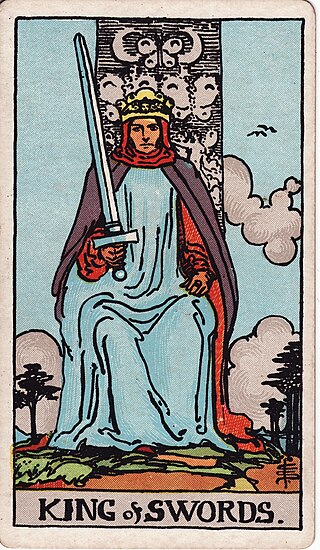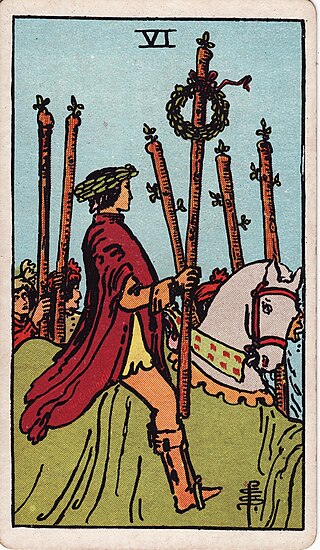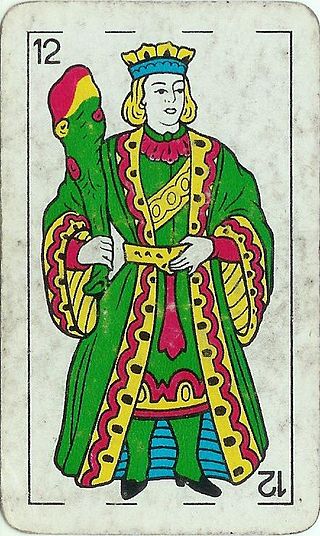
Tarot is a pack of playing cards, used from at least the mid-15th century in various parts of Europe to play card games such as Tarocchini. From their Italian roots, tarot-playing cards spread to most of Europe, evolving into a family of games that includes German Grosstarok and modern games such as French Tarot and Austrian Königrufen. In the late 18th century French occultists made elaborate, but unsubstantiated, claims about their history and meaning, leading to the emergence of custom decks for use in divination via tarot card reading and cartomancy. Thus, there are two distinct types of tarot packs in circulation: those used for card games and those used for divination. However, some older patterns, such as the Tarot de Marseille, originally intended for playing card games, are also used for cartomancy.

The Minor Arcana, sometimes known as the Lesser Arcana, are the suit cards in a cartomantic tarot deck.

The Rider–Waite Tarot is a widely popular deck for tarot card reading, first published by the Rider Company in 1909, based on the instructions of academic and mystic A. E. Waite and illustrated by Pamela Colman Smith, both members of the Hermetic Order of the Golden Dawn. Also known as the Waite–Smith, Rider–Waite–Smith, or Rider Tarot, the deck has been published in numerous editions and inspired a wide array of variants and imitations. Estimates suggest over 100 million copies of the deck circulate across over 20 countries.

The Magician (I), also known as The Magus or The Juggler, is the first trump or Major Arcana card in most traditional tarot decks. It is used in game playing and divination.

The Two of Wands is a Minor Arcana tarot card.

The Three of Wands, or Three of Batons, is a playing card of the suit of wands. In tarot, it is a Minor Arcana card.

The Four of Wands is a card used in Latin-suited playing cards which include tarot decks. It is part of what tarot card readers call the "Minor Arcana".

Five of Wands or Five of Batons is a card used in Latin-suited playing cards which include tarot decks. It is part of what tarot card readers call the "Minor Arcana".

The Six of Wands, or Six of Batons, is a card used in Latin-suited playing cards, which include tarot decks. It is part of what tarot card readers call the "Minor Arcana," the six of wands cards in divination decks with illustrated pip cards, displays a laureled horseman bearing a staff adorned with laurel crown. Footmen with staves are at his side.

The Seven of Wands is a Minor Arcana tarot card.

The Eight of Wands is a Minor Arcana tarot card. In the Rider–Waite deck, the card shows eight diagonal staves of staggered length angled across an open landscape with river, as designed by artist Pamela Colman Smith.

The Nine of Wands is a Minor Arcana tarot card.

The Page of Wands is a card used in Latin-suited playing cards which include tarot decks. It is part of what tarot card readers call the Minor Arcana.

Knight of Wands or Knight of Batons is used in Latin-suited playing cards including tarot decks. It is part of what tarot card readers call the Minor Arcana. Tarot cards are used throughout much of Europe to play tarot card games.

The Queen of Wands is a court card in the Minor Arcana set of the tarot.

The King of Wands, or King of Batons, is a card used in Latin-suited playing cards which include Italian, Spanish, and tarot decks. It is part of what tarot card readers call the "Minor Arcana".

The Ace of Wands is a tarot card of the Minor Arcana, arcana being Latin for mysteries. The cards of the Minor Arcana are considered to be lesser compared to the Major Arcana because they discuss the minor mysteries of life, less important archetypes. Modern tarot readers interpret the Ace of Wands as a symbol of optimism and invention.

The suit of wands is one of four suits in tarot, collectively known as the Minor Arcana. Like the other tarot suits, the suit of wands contains fourteen cards: ace (one), two through ten, page and knight, queen and king. When Tarot cards are to play Tarot card games, where wands corresponds to the suit of batons. Tarot cards came to be utilized for divinatory purposes by esotericists such as Eliphas Levi and were regularized into the divinatory form most known today by the Hermetic Order of the Golden Dawn and the Rider–Waite Tarot, created by a Golden Dawn member.

The suit of cups is one of four suits of tarot which, collectively, make up the Minor Arcana. They are sometimes referred to as goblets and chalices. Like the other suits of the Minor Arcana, it contains fourteen cards: ace (one), two through ten, page, knight, queen and king. Historically, the suit represented the First Estate. Tarot cards were originally designed for card play and are still used throughout much of Europe to play various Tarot card games. However, in English-speaking countries, where the games are largely unknown, Tarot cards came to be utilized primarily for divinatory purposes. In modern card games, the equivalent suits are Hearts or Cups.

The suit of swords is one of the four suits of the Minor Arcana in a 78-card cartomantic tarot deck. It is derived from the suit used in Latin-suited playing cards, such as Spanish, Italian and Latin-suited tarot decks. Like the other tarot suits, it contains fourteen cards: ace (one), two through ten, page, knight, queen and king. Occultists claim that the suit represents the Second Estate.




















